8 Military Aviation
Lucas Mullis
8.1 Introduction
Keywords
- Vietnam war – was a conflict that took place from 1955-1975 with active US engagement for almost that entire duration of time. It was a conflict that’s interest was almost entirely rooted in outside politics where two sides backed different heads of government during the peak of the Cold War
- Korean war – a conflict that can be directly attributed to the cold war; it lasted from 1950-1953. Fought between the Communist north; and democratically backed south; hasn’t really ended, conflict has just ceased
- Military Aviation – the use of aircraft and other flying machines for the purposes of conducting or enabling warfare
- Air Force – a common term given to a nation defense sector relating to planes and flying machines (military aviation)
- Interdiction – the action of prohibiting or forbidding something; in our case a military sense; often interrupting supply lines or communication
- Turbine – a machine for producing continuous power in which a wheel or rotor, typically fitted with vanes, is made to revolve by a fast-moving flow of water, steam, gas, air, or other fluid
- Drone – a remote-controlled pilotless aircraft or small flying device; often used for surveillance
- Civil War – the war between the Union (northern states) and the Confederate states of the South, it took place between 1861–65
- The Great War (WWI) – a European conflict that took place between 1914-1918 often referred to as WWI; later brought in nations such as the United states to finish the conflict
- Crimean war – a conflict largely on the Crimean peninsula, from 1853-1855 between the Russian Empire and the British-Turkish alliance
- Cavalry – soldiers who fought on horseback
- World War II (WWII) – a conflict between 1939-1945 that engaged most of the world’s powers in a costly conflict
- Global positioning system (GPS) – an accurate worldwide navigational and surveying facility based on the reception of signals from an array of orbiting satellites
- Helicopters – a type of aircraft which derives both lift and propulsion from one or more sets of horizontally revolving overhead rotors
- Desert Storm 1 – American military codeword used to refer to the First Gulf War, an American-led military conflict which lasted between 2 August 1990 and 28 February 1991
- Desert Storm 2 – American codeword for the second Gulf War
- War on Terror – a term used to cover a large amounts of wars on Terrorism from 2001 up to today
Learning Objectives
By the end of this chapter, students should be able to:
- Compare and contrast different eras of military aviation
- Compare and contrast the different technological advancements/pace of innovation in military aviation between eras
- Understand the origins of military aviation and where it is today
- Consider the future outlook of military aviation
From the beginning of human history people have looked to the skies in awe, wondering what it would be like to be up there. As time went on human perception shifted, it was no longer people wondering, but it quickly became what can we do with this? Humans went from hot air balloons to planes in almost no time, why? Because it offered a competitive advantage. Aviation quickly turned from a passion and a dream humans had to something we needed to use to guarantee safety and more effectively conduct warfare. Throughout the years, military aviation has changed greatly. Pace of innovation was rapid throughout military technology. From hot air balloons to planes in less than 70 years military aviation history is perhaps the most rapid and intriguing facet of military technology.
8.2- What is Military Aviation?
Key Takeaway
What Military aviation is and why it’s important; particularly in its role in the defense of a modern nation.
8.2.1- Defense and role
As the name implies Military Aviation is a term that refers to the use of aircraft and other flying machines for the purposes of conducting or enabling warfare. Armed conflict has always been the source of many great technological advancements, and its effects on aircraft development has been profound. The role of Military Aviation is often to protect the nation from potential bombing attacks as well as protecting a nation from invasion by sea. But Air force(s) are also tasked with offensive duties in times of war, these duties can include strategic bombing, interdiction, close air support, intelligence gathering, battlespace management and transport functions (Dutoit & Picand, 2015).
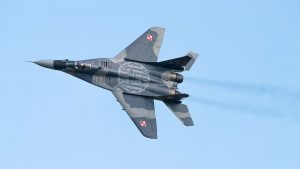
“105 Polish Air Force MiG-29A Fulcrum ILA Berlin” by Julian Herzog is licensed under CC BY 4.0.
8.2.2- Technological unlock & societal benefits
That’s not the only important role Military Aviation has, military technology trickles down to all levels of society, as such it’s not only advancing defense systems, it also produces useful technology for society. Examples of this would be sonar, followed by Global Positioning System (GPS). As nations, like the United States, devote massive amounts of government funding toward military aircraft and their innovation, society gains new technologies. They have directly brought us new kinds of Turbine(s) as well as many drone technologies. Proving that while they are a crucial part of defense, they also play a large part in unlocking new technologies (Aerotech News, 2019).
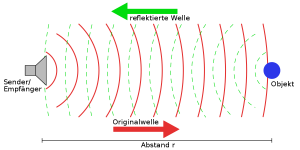
“Sonar Principle DE” By Georg Wiora (Dr. Schorsch) is licensed under CC BY-SA 3.0.
8.3 History of Military Aviation
Key Takeaway
8.3.1 Early uses of flight to aid Military advances
Some of the earliest cases of humans using aircraft to help during wartime goes back to the Civil War. In many battles commanders used Hot air balloons so they could survey the area and scout the enemy during battle. Since cannon fire, terrain, and troop movements impede the vision of commanders; the adaptation of the Hot air balloon proved creative, although not overly useful. There was no instance when Hot air balloons clearly won one side the battle over the other, but it surely helped aid whichever side used them (primarily used by northern armies). But this does not mean this wasn’t a pivotal step; the military experimented with many kinds of balloons for scouting purposes realizing that birds eye intel could be crucial in many encounters. This led to large investments into a plethora of intelligence technologies to improve combat readiness (Mercado, 2017).
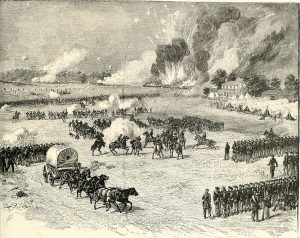
“Abraham Lincoln and the battles of the Civil War” by The Century Co. is licensed under Public Domain.
8.3.2 – The start of planes being used in a military sense
In an age of rapid military change, perhaps the biggest innovation at the time was the plane. Many people often attribute this to kitty hawk and the Wright brothers, although their discovery is now beginning to become argued in historical circles. Either way; what the Wright brothers surely did was rejuvenate a wonder for manned flight. The Military already knew that getting bird’s eye views were crucial in staying one step ahead of their opponent, but little did they know just how rapidly they would develop this technology. With the Civil War taking place in the early to mid 1860s; society had gone from Hot air balloons to early Biplanes. In a time where trench warfare gripped Europe, information on your opponents was hard to come by. The Great war (WW1) was a perfect storm of technology outpacing leadership (Driver, 1997). Between the Crimean war and WW1, machine guns, battleships, and even early tanks had been created. All at a time where most military leadership still thought Cavalry charges were a good idea. All of these technologies caused extreme stand stills between the European powers, neither able to gain a tactical advantage over the other, especially while using outdated tactics. That’s where the invention of the Biplane comes in. Not only could a pilot control a biplane without being entirely reliant on wind, they could also go at relatively fast speeds, enabling pilots to conduct missions to gather crucial information on the movement of their enemies. Unfortunately, the technology was not perfect, machine guns were great counters to WW1 aircraft and there are stories of regular infantry shooting planes out of the sky. But Military Aviation learned from this, and after the conclusion of the Great War massive innovation occurred during a time of relative peace. (Williams, 1999)
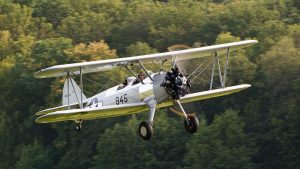
“Boeing PT-17 Kaydet A75N1 N54945 OTT 2013” by Julian Herzog is licensed under CC BY 4.0.
8.3.3 – WWII, Korea, &, Vietnam plus rapid pace of innovation
After the Great War, a time of relative peace overtook the world. But technological advancements never stopped. Military’s learned a lot about the usefulness, but also the vulnerabilities of aircrafts during the Great War. So during this time of peace they tried to make their Air forces capable of counteracting these vulnerabilities. They took into account the amount of damage machine guns could do to their aircraft and decided they needed to reinforce the armor of the aircraft. They had heard that the guns on the aircraft were wildly inaccurate, and that they quickly ran out of ammo. To solve this they created a system that allowed for quick loading times when the aircrafts landed and semi-easy access to the guns in case they jammed (although this still was a major problem). At the beginning of World War II (WWII) some of the most infamous aircraft came into existence. The Spitfire, Messerschmitt, P-51 Mustang and many other aircraft dawned the skies during the war. All of these aircraft were designed based on lessons from The Great War and were now more equipped to deal with the ever evolving technologies the war produced. (Prime Industries, 2020). Something you notice about all of these planes though is that they are still propeller planes. That didn’t last long. By the end of WWII the Germans unleashed the first jets the world had seen. In 6 years of conflict aircraft had gone from propellers to jets. A huge leap in aviation technology, propellers are limited by how fast you can get the propeller to rotate, while a jet changes the process, unlocking speeds not even imaginable by propeller planes. But that’s not where the innovation stopped. Directly after WWII multiple other large scale conflicts occurred. In particular the Korean war. (Malkashian, 2017)
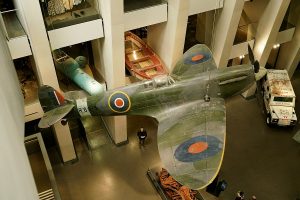
“Supermarine Spitfire at Imperial War Museum London” by Peter Trimming licensed under CC BY-SA 2.0.
8.3.3 Korea & Vietnam
By the Korean War, American aircraft were unrecognizable compared to their WWII predecessors. The mustang made up the majority of the American aviation forces during WWII, and while they still were used in the Korean war other planes had begun to take over the skies. The perfect embodiment of this change is the F-94 Starfire; a plane that was born out of innovation and created to counteract that of America’s enemies. The whole world was in a time of massive technological innovation, and to counteract the leaps the Soviets had made, the F-94 starfire was created to intercept the new high-level soviet bombers capable of nuclear attacks (Military factory, 2018). The Starfire was far from the only major aircraft created during this time, but between WWII and the Korean war another piece of technology was created. We know it as helicopters. One of the earliest helicopters was the Bell Model 47 created in 1946. Although created in a time in between wars, the Bell Model 47 proved its worth almost immediately in Korea, acting as a light-easily maneuverable aircraft, capable of scanning a region and re-deploying men in little to no time. (Military factory, 2018). Even though the Korean war ended in a stand still, technology did not stop pushing forward. This leads us to the Vietnam war. Vietnam was the point where our pace of innovation was actually faster than our testing and proper implementation of our technology. In Vietnam we tried to implement heat seeking missiles onto some of our fighter jets. Only problem with that is it took time to line up and fire these missiles, and they didn’t always destroy our target, meaning that inferior planes could destroy our modern jets with crafty maneuvering and a bit of luck (Military factory, 2018). Vietnam also ended in a somewhat standstill, but the civil war was still at its peak; leading us into what is considered modern military aviation, with a newer age of jets.
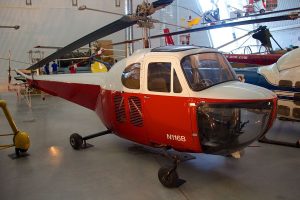
“Bell Model 47B” by Mike Peel is licensed under CC BY-SA 4.0.
8.3.4 Modern aviation history
The modern age of military aviation is often considered to begin around the conclusion of the Vietnam war. Upon the Vietnam war’s conclusion a lot of money was invested in creating the next class of aircraft. This class yielded some very famous aircraft, many we still use today. The perfect embodiment of this is the F-15, and the F-15 raptor as well as the F-22 (Schanz, 2012). This aircraft has been changed and tweaked throughout the years but it still is top of its class. Most major air forces across the world have been in a state of peace since the early 2000s, but many stealth bombers and surviellance aircraft are still being used to this day in the middle east. While the days of dog fights seem to have passed us, the air force is not useless by any stretch. They still serve an immense tactical and defensive purpose, while also carrying out offensive missions like strategic bombings. This fleet, while not used in any massive wars, was deployed all through Desert storm 1 and Desert storm two. While also being heavily used in the War on Terror. Now as many of these planes get decommission we begin to look towards what the future holds (US Airforce, 2012).
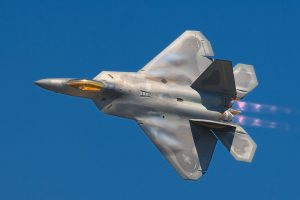
“Lockheed Martin F-22A Raptor” by Rob Shenk is licensed under CC BY-SA 2.0.
8.4 – The Impact of Military Aviation on the world
Key Takeaway
Throughout this chapter you will learn the pros of military aviation, particularly about the technologies military aviation has created for society. You will also learn about potential negatives of Military overspending.
8.4.1 – Pros of Military Aviation
The air force is often considered the modern backbone of most countries’ military protection services. While the Airforce often relies on other branches for much of its infrastructure, surveillance and intelligence would not be nearly as plentiful without a strong Air Force. Not only does a strong air force deter potential attackers, it also enables a nation to see when their neighbors are mobilizing an attack force. But that’s not the only impact Military Aviation has on society, there are many notable advancements, but let’s start with something as simple as velocity. Until the airforce tested high speed aircraft, we knew it was safe for humans to experience sustained high speeds in aircraft. They also tested if ejections could happen out of aircraft going supersonic speeds enabling future innovations in commercial aviation as well as aviation centered around space travel. Jets were originally created for military purposes, but their blueprint is what enables commercial aircraft as you know it would not be where it is today without many military breakthroughs with cockpit and pressurized technologies (Aerotech News, 2019). But arguably the most overlooked thing the Military brought to us was satellite communication, without this investment into Military Aviation, many systems simply wouldn’t exist or would have come about later in time. Things like GPS, the internet of things, Cellular, and much much more wouldn’t function without satellite communication (Aerotech News, 2019).
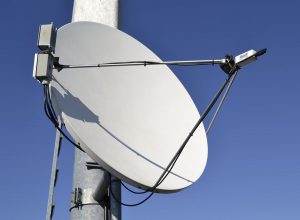
“Satellite dish in Austria” by High Contrast is licensed under CC BY 3.0 DE.
8.4.2 – Cons of Military aviation
While the military provides lots of benefits it does have some down sides. Much of the technology the military does create takes substantial time to trickle down into society, meaning that if other institutions would have been given this funding maybe certain inventions would have hit the market at earlier times. A lot of people support the idea that if NASA had a budget remotely close to that of the Military, that space and other cutting edge technologies would be far more developed (Red, 2018). The Military also spends exorbitant amounts of money every year when people often argue that this money should be spent on other things like social programs.

“Defense spending” by Wikideas1 is licensed under CC0 1.0.

“Medicare for All Town Hall, San Jose, California” by Ro Khanna is licensed under Public Domain.
8.5 – The Future of Military Aviation
Key Takeaway
8.5.1 – Drones & Unmanned aircraft
The future of Military aviation is upon us. Currently we have drones capable of dropping bombs and gathering surveillance. The main aim of much of the military is to have the large majority of aircraft be unmanned so as to mitigate loss of military personnel. The Air force academy in the United states has training in simulations so recruits can operate these unmanned vehicles. The future initiative is to not only perfect the technology, but to have it run by software/machines that interpret information such as artificial intelligence (AI). While that thought is scary to some people, many surveillance drones are already beginning to become unmanned and operated entirely by AI. This is a major step up in surveillance technologies. No longer will someone need to be awake and conscious to gather information, a robot could be doing it all on its own (Gohardani, 2012).
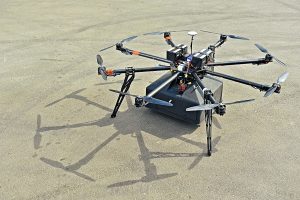
“Drones” by Dodo Pizza World is licensed under CC BY-SA 2.0.
8.5.2 – Space
Since the dawn of time people have looked to the stars and wondered what’s out there. Now we’ve visited the stars. The military’s next goal is to control the space we exist in. We don’t have a space flotilla yet, advances are currently more targeted toward stealth bombers and surveillance aircraft that are undetectable and leave Earth’s atmosphere. Then we touch on the idea of fleets capable of traveling at massive speeds using the earth’s gravitational pull to travel to locations before or directly after an attack has been made on a region. The goals of these technologies would be both offensive and defensive use, enabling a nation to be a step ahead of the rest of its forces and assumably their opponents forces as well (Gohardani, 2012). With future outlook towards weaponizing space and exploring the solar system, the military has not quite stated the direction in which it intends to travel, but what we do know is that Space will be the final frontier.
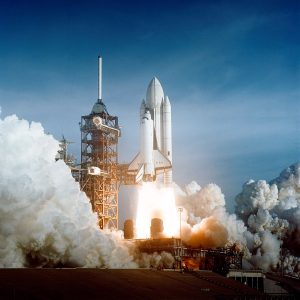
“Space Shuttle Columbia launching” by NASA is licensed under Public Domain.
Case study: How GPS saves people on the daily
Everyday millions of people use GPS to help them get around to where they need to go. But they aren’t just useful for that. People with dementia and Alzheimers rely on GPS to get them where they need to go, without letting them forget their destination. But that’s all general ways GPS saves people, let’s focus on a few stories that without GPS (a technology that is enabled by military advancements and satellite communication) disaster could have struck. There’s a story originating from Rowlet Texas, where a 15 year old girl with Asbergers goes walking alone. The mother knows her daughter isn’t good at communicating, so she has a GPS bracelet on her daughter’s wrist. Luckily when she sees her daughters deviated from her normal path she knows somethings up, she instantly goes to her car and start to follow to tracker; luckily for her, her daughter had actually been kidnapped and was about to be sexually assualted. But upon noticing the bracelet the attacker dropped off her daughter and drove away in a hurry. Thus saving her daughter from an already traumatic experience becoming a far worse one. That’s just one of many stories daily, GPS saves people from bad scenarios everyday. Another case would be that one day two young boys were out on a small boat, their boat capsized but luckily for the boys they had on life jackets. The current ended up sweeping them to an island not too far from their crash. But since the boys had GPS trackers on they were quickly found and rescued which entirely avoided what was likely to be a multi-day search. Without GPS these two stories and millions more could have gone horribly wrong, GPS truly does save people daily, and not always by enabling them to get where they need to. (Leaders, 2020)
Chapter Summary
Throughout this chapter you will have learned what military aviation is, what it does, its history, and the future directions the area is headed. However we also covered the downsides of investing heavily into military technologies and discussed the potentially slow trickle down time of discoveries the military makes. Despite the flaws that the Military has, many good things have come into being because of Military aviation and without it, the Commercial Aviation sector would not be nearly as prominent as it is today.
Review Questions
1. What was the earliest use of aircraft in a military sense?
A. Plane
B. Hang Glider
C. Space Shuttle
D. Hot Air Balloon
2. What are potential flaws of Military aviation covered in the chapter?
A. Inhumane
B. Controversial
C. Slow & costly
D. Not a necessary expense
3. Which is an example of a technology created for Military Aviation?
A. Satellite communication
B. Parachute
C. Propeller planes
D. Binoculars
4. What was a name of a plane used in WWII?
A. Mustang
B. F-22 raptor
C. F-15 raptor
D. Biplane
Answers
-
- D
- C
- A
- A
Food for Thought
- Do you agree with the current direction of Military aviation and advancement?
- Is Military Aviation too expensive and should we spend the money elsewhere?
- Do you think we would be more or less advanced in technologies like Satellite Communication if it weren’t for the Military creating it?
- Do you think that the future truly is unmanned aircraft? If so, how do you feel about Artificial intelligence?
References
Driver, H. (1997). The Birth of Military Aviation. Google Books. Retrieved November 23, 2021, from https://books.google.com/books?hl=en&lr=&id=cbrA5NJp2JMC&oi=fnd&pg=PP11&dq=early%2Bmilitary%2Baviation&ots=kPtPfHefNb&sig=v0nIfPEtcu_4Aj-qvRsgQgZWme8#v=onepage&q&f=false.
Dutoit, D. D., & Picand, Y. (2015). Military aviation. Military aviation : definition of Military aviation and synonyms of Military aviation (English). Retrieved November 26, 2021, from http://dictionary.sensagent.com/Military%20aviation/en-en/#anchorWiki.
Factory, M. (2018). Bell Model 47. Military Factory – Global Defense Reference. Retrieved November 26, 2021, from https://www.militaryfactory.com/aircraft/detail.php?aircraft_id=1138.
Factory, M. (2018). Lockheed F-94 Starfire. Military Factory – Global Defense Reference. Retrieved November 26, 2021, from https://www.militaryfactory.com/aircraft/detail.php?aircraft_id=365.
Gohardani, A. S. (2012, December 6). A synergistic glance at the prospects of distributed propulsion technology and the electric aircraft concept for future unmanned air vehicles and commercial/military aviation. Progress in Aerospace Sciences. Retrieved November 23, 2021, from https://www.sciencedirect.com/science/article/abs/pii/S0376042112000735.
Industries, P. (2020, March 11). The most famous WWII aircraft. Prime Industries. Retrieved November 26, 2021, from https://primeindustriesusa.com/famous-wwii-aircraft/.
Leaders, G. P. S. (2020, June 24). GPS tracking saves lives daily. GPS LEADERS. Retrieved November 26, 2021, from https://gpsleaders.com/gps-tracking-saves-lives/#:~:text=GPS%20tracking%20devices%20are%20really%20saving%20the%20lives,see%20his%20parents%20or%20find%20the%20way%20home.
Malkasian, C. (2001). The Korean War 1950-1953. Google Books. Retrieved November 23, 2021, from https://books.google.com/books?hl=en&lr=&id=ZGoA65bSFpQC&oi=fnd&pg=PA7&dq=korean%2Bwar%2Baircraft&ots=cv2h3uIh0F&sig=B2m4xiOnf6OH3uc8bqoqjCzhT7M#v=onepage&q=aircraft&f=false.
Mercado, M. (2017). The rise and fall of lighter-than-air aircraft … – opensiuc. The Rise and Fall of Lighter-Than-Air Aircraft, 1783 – 1937. Retrieved November 23, 2021, from https://opensiuc.lib.siu.edu/cgi/viewcontent.cgi?article=1029&context=legacy.
News, A. (2019, November 15). Technological Innovations in the history of the U.S. Air Force. Desert Lightning News – Nellis/Creech AFB. Retrieved November 26, 2021, from https://www.aerotechnews.com/nellisafb/2017/09/15/technological-innovations-in-the-history-of-the-u-s-air-force/.
Red, R. (2018, December 30). What if NASA had the US military budget? RankRed. Retrieved November 26, 2021, from https://www.rankred.com/what-if-nasa-had-the-us-military-budget/.
Schanz, M. (2012). The last raptor – airforcemag.com. Air Force Magazine. Retrieved November 23, 2021, from https://www.airforcemag.com/PDF/MagazineArchive/Documents/2012/February%202012/0212raptor.pdf.
U.S. Air force. (2012). Air Force Association. Retrieved November 23, 2021, from http://secure.afa.org/members/commtools/F-22_Talking_Points_10_May_2012.pdf.
Williams, G. (n.d.). Biplanes and Bombsights: British bombing in World War I. Google Books. Retrieved November 23, 2021, from https://books.google.com/books?hl=en&lr=&id=s6pvCwAAQBAJ&oi=fnd&pg=PT4&dq=biplanes&ots=Aa_usM534x&sig=bJnE4fW69f2JgtzGHnVdkrmLQws#v=onepage&q=biplanes&f=false.
The use of aircraft and other flying machines for the purposes of conducting or enabling warfare.
A common term given to a nation defense sector relating to planes and flying machines (military aviation).
The action of prohibiting or forbidding something; in our case a military sense; often interrupting supply lines or communication.
An accurate worldwide navigational and surveying facility based on the reception of signals from an array of orbiting satellites.
A machine for producing continuous power in which a wheel or rotor, typically fitted with vanes, is made to revolve by a fast-moving flow of water, steam, gas, air, or other fluid.
A remote-controlled pilotless aircraft or small flying device; often used for surveillance.
The war between the Union (northern states) and the Confederate states of the South, it took place between 1861–65.
A European conflict that took place between 1914-1918 often referred to as WWI; later brought in nations such as the United states to finish the conflict.
A conflict largely on the Crimean peninsula, from 1853-1855 between the Russian Empire and the British-Turkish alliance.
Soldiers who fought on horseback.
A conflict between 1939-1945 that engaged most of the world's powers in a costly conflict.
A conflict that can be directly attributed to the cold war; it lasted from 1950-1953. Fought between the Communist north; and democratically backed south; hasn’t really ended, conflict has just ceased.
A type of aircraft which derives both lift and propulsion from one or more sets of horizontally revolving overhead rotors.
A conflict that took place from 1955-1975 with active US engagement for almost that entire duration of time. It was a conflict that’s interest was almost entirely rooted in outside politics where two sides backed different heads of government during the peak of the Cold War.
American military codeword used to refer to the First Gulf War, an American-led military conflict which lasted between 2 August 1990 and 28 February 1991.
American codeword for the second Gulf War.
A term used to cover a large amounts of wars on Terrorism from 2001 up to today.

